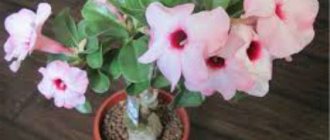Abutilons are excellent indoor plants, easy to care for, quickly growing and blooming for a long time. They have been known to people since ancient times, but their homeland has not been established, since in the wild they are distributed throughout the world in subtropical and tropical climates. This genus of plants is represented by over one hundred species.
About a dozen are used for growing at home, but breeders have developed many hybrids and varieties that differ in leaf shape and color. Hybrid abutilones are prominent representatives and have gained great popularity due to their easy care and long-lasting dense flowering.
For example, hybrid abutilon Juliet is an ornamental evergreen shrub that grows quickly and begins to bloom within 4-5 months after sowing the seeds. With good lighting and regular watering, it blooms with bell-shaped pink, red, orange or golden flowers with a diameter of 5-6 cm all year round. There are abutilon hybrid Juliet seeds (a mixture of colors) that can be bought at a flower shop. Even a novice gardener can grow this elegant plant.
Another popular representative of hybrid abutilon is another indoor plant - organza abutilon, whose flower petals are wide and veined. The color of the inflorescences ranges from very light to the most saturated shades. In addition to white, it comes in pink, golden or orange. Externally, the shrub is a little similar to Abutilon Juliet. Both varieties are low-growing and bloom profusely.
Often gardeners like to have multi-colored flowers on one bush. For such wishes, there are ready-made varietal mixtures. These include abutilone hybrid mixture Bellevue. They are so called because they are obtained by crossing different types of abutilone and are collected from varieties that do not have an individual name, but are all characterized by common characteristics.
Abutilons are valued as beautiful, abundantly flowering subshrubs because with good care, the plant's flowering can last all year round.
Description and characteristics of the plant
The rope maple belongs to the genus Abutilon in the family Malvaceae. This genus of plants includes approximately 150 species of various perennial and annual shrubs, herbs and also trees. However, out of this large number of species, only a few of them are grown as ornamental plants.
Did you know? Coarse abutilone fibers are used for the production of ropes and various woven products. Thanks to this feature, this plant received its second name “rope plant”.
Abutilon is a small tree or shrub that remains green all year round. The plant is native to South America, and in particular Brazil. Under natural conditions, the ropeworm is found in Africa and the subtropical and tropical zones of Australia, China and India.
This plant has dense stems that weave strongly at the base. The bark of woody shoots has a brownish-purple tint. Along the entire trunk there are graceful leaves, the size of which varies from 10 to 20 cm, and the shape resembles a maple or grape leaf.
In appearance, the flowers resemble a bell, but depending on the variety, they can be found in the shape of a cup, and are directed downward. The length of the flower can be 4–8 cm.
They are smooth and terry, and the color of the petals is white, cream, orange, pink, red, violet and purple. The buds bloom for several days, but new bells or calyxes appear in place of the fading ones.
Flowering is lush and long-lasting, beginning in April - May and lasting until October - November. Considering its decorative appearance, the question arises: can it be kept at home?
This plant can be found both in front gardens and in gardens or parks, however, from all the diversity, some varieties of rope plant have been bred and grown as indoor plants. With proper care, indoor species can reach 2 m in height.
Thanks to the work of breeders, varieties have been developed that have compact sizes, strong branching of the trunk, and a wide variety of shades of flowers and leaves.
Ornamental flowering plants also include Tabernemontana, Jacobinia, Pentas, Crossandra, and Oleander.
Only the following species are grown as home flowers:
- abutilon Bella;
- Darwin's cable car;
- Megapotamian cable car;
- Bellevue cable car;
- striped or spotted ropetail;
- hybrid cable car;
- suntense cable car;
- abutilon pink panther;
- panther roper;
- abutilone grapeleaf;
- abutilone isabella;
- abutilon AS-Kishmish;
- ropeman of Theophrastus;
- organza rope;
- roper Isabella;
- chicken abutilon;
- apricot rope;
- abutilone Zlata;
- dwarf ropetail;
- abutilone variegated;
- abutilone wedge-shaped;
- Amazonian ropeweed;
- variegated ropeweed;
- abutilone yellow.
In addition, flower lovers who are worried about their loved ones and decided to acquire this variegated plant are interested in whether this flower is poisonous or not, because many tropical plants have toxic properties.
Abutilone is not a poisonous plant, but even has a number of beneficial properties and is widely used in folk medicine in its homeland. A decoction of abutilon leaves is used to wash ulcers and wounds; it is also used as a rinse for stomatitis and during teething.
It can be used to relieve symptoms of fever or cold. A compress based on leaves and flowers is used for wounds and burns that are previously crushed.
In addition to traditional medicine, it is also used in official medicine. Research on this plant has proven that it contains antioxidants, hepatoprotectors and immunomodulators, thus it is a natural antibacterial, antimalarial, antimicrobial or anti-inflammatory agent.
1.Description - what it looks like
Abutilon, ropewort or indoor maple is an attractive, flowering herbaceous annual or perennial plant, shrub or small tree. The genus includes several hundred species of plants - according to various estimates, from 100 to 400 species that can adapt to a wide variety of environmental conditions.
Among the abutilons there are large perennial shrubs and subshrubs, as well as very small herbaceous plants inhabiting different parts of the globe. Only a small part of the plants is grown as ornamental and potted plants.
The bushes have strong, erect, branched shoots, which over time become lignified and covered with light brown bark. The leaves are glossy, green, dissected into 3 - 5 fingers, reaching a length of 10 cm. Small denticles are located along the edges of the leaf blades. The leaves are arranged alternately, on long and thin petioles. There are spectacular varieties with variegated leaf blades.
↑ Up,
The flowers are large, cup-shaped, drooping, with 5 wide heart-shaped petals, reminiscent of mallow or hibiscus. Flowers are arranged singly or in small inflorescences. The diameter of the buds of varietal plants can reach 7 cm. The color of the petals is most often in pastel colors - includes yellow, orange, pink, white and red shades.
In some plants, the petals have 2 shades at once - the veins are often painted in a more saturated color. There are also double forms of abutilon and plants intended for growing in hanging pots - hanging varieties. The latter are characterized by long, drooping shoots that hang over the edges of the pots in a beautiful cascade.
↑ Up,
After flowering, seed pods form on the bushes, which become dry and brown when ripe. The boxes contain up to one and a half dozen darkly colored heart-shaped seeds.
The genus name Abutilon comes from the Arabic word "aubutilun". It was given to plants by a Persian physician and astronomer named Avicenna.
The name “abutilon” is translated as “shade-giving” - for its thick and furry crown with large leaves. The flower was nicknamed indoor maple for the characteristic, finger-shaped shape of its leaf blades, reminiscent of maple. It was nicknamed the ropemaker for the strong fibers contained in the twigs, which Indians use to produce durable ropes and burlap.
Height . At home, the height of abutilon can reach 2 meters, but it can be easily adjusted with regular haircuts. There are plants whose height, even in adulthood, does not exceed 50 - 60 cm. In their natural habitat, trees can reach 4 meters in height.
↑ Up,
Optimal conditions for growing a flower
Ropeweed is quite easy to care for and does not require special growing conditions. It is necessary to choose the right workplace, choose the right pot and soil, regularly water, fertilize and prune.
The domestic maple, as a representative of tropical and subtropical plants, is light-loving, so it is necessary to provide a sufficient level of light not only in summer, but also in winter. If there is not enough lighting, the plant stops blooming and the shoots begin to stretch.
To avoid these problems, it is best to choose a south-facing window for the winter, but in the summer it is necessary to avoid direct sunlight, as they can harm young shoots. In summer, the rope plant can be moved to a loggia, open terrace or garden, but the plant should be protected from the wind.
In the warm season, the optimal temperature is +22…+25ºС, and in winter - +12…+15ºС. If the temperature drops below +12ºС, the plant sheds its leaf cover. The same consequences can occur as a result of exposure to drafts.
Additional moisturizing is not required. In winter, when the flower is in close proximity to the radiator, there is no proper watering and ventilation of the room, the air becomes dry, the leaves begin to dry and curl, so you should periodically humidify the air.
This can be done using a mist or a humidifier. It will also be useful to periodically bathe the plant in a warm shower (once or twice a month).
If in winter the temperature in the house rises above +15ºС, then abutilon is watered as necessary (when the soil dries out). However, you need to monitor the soil so that it does not become waterlogged or dry out, because the leaves may fall off. In summer, the frequency of soil moisture increases to 3 times every 7 days.
Important! Indoor maple needs abundant watering during the period of active growth; in winter, when the temperature remains within +12...+15ºС, watering is reduced.
Domestic maple needs regular fertilization, so during the growing season it should be fertilized once every 10–14 days. Fertilizing is applied both with watering and by spraying, alternately using mineral and organic complexes.
If with the onset of winter abutilon does not stop blooming, then fertilizer is continued to be applied. If there are no buds during this period of the year, fertilizer is no longer applied, thereby allowing the plant to rest and gain strength for the next flowering season.
The plant should be pruned periodically. Thus, an attractive shape is formed and the ropeworm reproduces. It is pruned in February - March.
Reproduction of Abutilone
A new tree can be obtained using seeds or cuttings.
Propagation of abutilone by cuttings
Usually, at the age of 5 years, the trunk becomes woody, and abutilon becomes less attractive. Propagation by cuttings is a good option for renewing a tree. It is better to do this from spring to late summer. Cuttings 15 cm long are cut from strong branches, clearing the lower leaves and flowers. Place, slightly tilting, in moist soil. Water, mulch, cover with film. To prevent condensation from accumulating, several holes are made. The seedlings are kept warm, at a temperature of 22 - 25°. The film is regularly removed for ventilation and watering. After a month, the cuttings take root and are transplanted into a pot.
Growing abutilone from seeds
Propagation by seeds is not always convenient: they quickly lose their germination capacity. It is better to sow last year's seeds. In the spring, large seeds are selected and treated in a solution of potassium permanganate. Furrows are made in the soil and the seeds are placed at a distance of 20 mm from each other, deepening them by 5 mm. The container with seedlings is covered with polyethylene. Make holes to allow the seedlings to “breathe”. Keep at a temperature of 20 - 23°C. The film is removed to moisten and ventilate the soil. After 3 weeks, the first shoots appear. When 2 leaves grow, the seedlings are planted in pots and placed in a bright place away from drafts. After 4 - 6 months, the abutilon will bloom.
Variegated species are propagated only by cuttings in order to preserve the biological characteristics of the parent plant.
Preparing for landing
Before considering the rules of transplantation, it is necessary to choose the right container for the ropeway and determine what kind of land is needed. When choosing a pot or other container for planting a flower, you must remember that the flower is replanted annually.
And since the flower grows quite quickly and the roots also develop rapidly, the container where the flower will grow must be deep enough. For young cuttings, choose a pot or flowerpot whose diameter varies between 7–10 cm.
Find out how to properly plant indoor flowers in a pot.
The rope plant prefers non-acidic, airy soil.
You can prepare the desired mixture at home using:
- 1 part humus;
- 2 parts of turf land;
- 1 part leaf soil;
- 0.5 parts sand.
You can also use ready-made soil, for example, “Palma”, which is sold in any flower shop.
Abutilone Theophrasti (A. Theophrasti)
Russians and residents of some other European and Asian countries know the Theophrastus abutilon shown in the photo under a different name - rope. Outwardly unattractive and not at all decorative, the plant has been used since ancient times to obtain durable fiber used to make twine, burlap and fiber for technical needs.
A small herbaceous plant with green, heart-shaped foliage and yellow flowers, it is still grown in China today as a valuable agricultural plant. To obtain the fiber, the stems are collected, dried and processed in a similar way to flax.
If only one abutilone is of economic importance, then there are much more decorative species that attract attention with the grace of foliage and flowers. Compact herbaceous and semi-shrub forms, including ampelous varieties of abutilon, as in the photo, are suitable for growing in pots or winter gardens in closed ground conditions. Moreover, the main value of such abutilons is their flowers, large, often bell-shaped or wide open.
Reproduction and planting technologies
Abutilone propagates in two ways: seeds and cuttings. After pruning the plant, a large number of cuttings appear that can be rooted. However, indoor maple can also be grown from seeds.
Cuttings
When wondering how to propagate rope plant while maintaining all the characteristics of an adult plant, cuttings are optimal, which can be used for any variety of abutilon.
In this propagation method, cuttings are used only from the top of the flower. Their length should be no more than 15 cm and have 3-4 leaves and buds. If there is a bud on it, then it must be cut off so that the plant can take root faster.
Important! Abutilon cuttings are planted in the spring so that by summer the plant becomes stronger and can delight you with lush greenery and flowering.
After cutting, the shoot does not need special treatment and can be immediately placed in a separate tall glass with moist soil. In order for it to take root well, greenhouse conditions are artificially created for it.
In this case, it is necessary to constantly maintain moist soil and air, provide a sufficient amount of light and an air temperature of +25ºС. If all conditions are met, then after 2 weeks the cuttings will take root and can be transplanted into a small pot.
If necessary, the flower is transplanted into a larger pot. These plants are cared for in the same way as adults.
Seeds
This method does not require special skills and is quite simple. The seeds need to be prepared first. To do this, they are sorted out and only the largest ones are left, after which they are soaked in water.
If some of them float to the surface, then these seeds must be selected, since they cannot be used for planting, because the germination rate will be very low.
Important! Hybrid varieties of abutilone cannot be grown from seeds, since the main characteristics of the mother plant will be lost.
A container with a mixture of peat soil and sand is ideal for sowing seeds. It is necessary to sow seeds to a depth of no more than 8 mm and no less than 5. After sowing, the soil is well moistened and covered with a lid or special film, thus creating a greenhouse effect.
The temperature must be maintained within +22…+28ºС. The container with the seeds is placed in a well-lit place. To prevent the air from stagnating in the minigreenhouse, it must be periodically ventilated and the soil must be moistened, if necessary, by spraying.
20–35 days after planting, the first shoots hatch. Plants can be replanted only when the sprouts have 3-4 leaves. The pots are changed gradually; in the first year you can replant the flower up to 4 times.
Plants grown in this way begin to bloom within 3-4 months from the moment of planting.
Useful properties of abutilone
Abutilone is a plant that gives joy. A sad mood transforms into a powerful charge of vigor; helps to reveal talents, creates an atmosphere of love and harmony. Contemplation of a flowering tree relieves stress. The type Abutilon Theophrastus is useful. Its juice is used to treat furunculosis and heal wounds. Strong ropes are made from abutilon branches. For this he is called a ropeman.
Features of care and cultivation
The rope plant grows quickly in favorable conditions, which is why it is necessary to provide optimal conditions and care.
Fertilizer and watering regime
During the period of active growth, Abutilon needs regular feeding, which is done up to 3 times every 30 days. In the off-season, the rope plant must be given the opportunity to rest, so they stop applying fertilizer. However, if the plant blooms all year round, then fertilizer continues to be applied in the same mode.
Moisten the soil as needed:
- in summer - a couple of times every 7 days;
- in winter - a couple of times every 14 days, at temperatures above +15°C.
Flowering period
For novice flower growers, it is always interesting when the home maple tree blooms. It blooms in April or May and pleases with its flowering right up to November or October, however, if proper care is provided, the rope plant can bloom all year round.
Trimming and shaping
Since abutilon grows quite quickly, it needs regular pruning. It can be produced at any time of the year. However, it is better to form a crown in early spring, and during the growing season it is better to trim only weak shoots.
To form a tree and lignify one stem, it is necessary to periodically remove all side shoots. And in order to form abutilon bushes, you need to pinch the top of the plant. It is important to understand when to pinch the plant. To increase the branching of the rope plant, young shoots are pinched at the end of winter and beginning of spring.
Timing and technology of transplantation
You can replant a young flower several times during the first year, and starting from the second year, replanting is done every year and only in the spring. Large plants are replanted no more than once every few years. The container should be one finger larger than the previous one. In such a container the plant will grow rapidly and bloom profusely.
Transplantation is carried out by transferring a clod of earth, thus minimizing the likelihood of damage to the root system. Expanded clay, pebbles or clay shards are used as a drainage layer.
Types of homemade abutilone with name and photo
More than 100 types of abutilone are known. Some of them, adapted to home life, are grown at home. They are small in size, bloom for a long time and do not require special maintenance conditions.
Abutilon Megapotamicum, or Abutilon Amazonian
The shrub grows up to 1.5 m. The stems are thin and drooping. The length of the elongated oval leaves with jagged edges reaches 8 cm. Single flowers hang on long stalks. The red corolla has a tubular-ribbed shape.
The petals, which have a red spot at the base, are yellow. With proper care it blooms all year round. In England it is called a “weeping Chinese lantern.”
Abutilon Vitifolium
A tall branched shrub, grows up to 2 m. Bright green leaves with jagged edges reach 20 cm, have from 3 to 5 lobes. The inflorescences are painted blue or lilac, with dark veins on the petals. The flowers are arranged in groups. Long shoots are covered with fluff. Blooms from late April.
Abutilon Sellowianum
Grows up to 2 m. Slightly branched straight shoots are pubescent. The pointed, elongated, three-lobed leaves have a smooth texture and serrated edges. The flowers are soft purple with pink veins. The flowering period falls on July - December.
Abutilon spotted, or Abutilon painted (Abutilon Pictum / Striatum)
A shrub with flexible short shoots and multi-lobed green leaves on long petioles. They have a heart-shaped appearance, white spots and jagged edges. Golden flowers with dark pink veins are shaped like a bell. Formed in the axils of leaves. Flowering occurs at the very end of summer.
Abutilon hybrid (Abutilon Gybridum)
Abutilone is obtained artificially by crossing different plant species. An evergreen tree 1.5 m high. Petals can be painted in different colors: pink, white, orange, red, yellow, burgundy. Veins are always visible on them - dark or light. The shape of the flowers resembles bells. The leaves are covered with delicate hair, have 3–5 lobes and long petioles.
Abutilon is a beautiful plant that can refresh and decorate the interior. Brings peace and joy to the home. It is responsive to basic care, and with good care it is ready to bloom all year long.
Diseases and pests
Unfortunately, abutilone can be affected by the following pests:
- scale insect;
- aphid;
- whitefly;
- spider mite;
- mealy worm.
As a result of such exposure, various leaf diseases develop. To combat these pests, special preparations are used or the leaf plate can be treated with a mild soap solution. When identifying spider mites, it is enough to increase the air humidity. This can be done by using a humidifier or spraying the flower.
Did you know? Abutilone cryptopetalum is included in the Red Book of the United States. To restore its population, seeds of ripened fruits are collected, which are first grown in special nurseries, and then the plant is transplanted into the natural environment.
If the soil is waterlogged, the plant may develop root rot. In order to combat this problem, it is necessary to adjust the watering regime and prevent soil acidification. Chlorosis may also occur, which is a consequence of the negative influence of spider mites.
Why doesn't it bloom
Abutilon may not bloom if the soil is waterlogged or overdried, which most often happens in winter or summer under the influence of direct sunlight. Buds may form poorly or not form at all if the soil is depleted or the pot is small.
In addition, the plant needs regular pruning to ensure lush flowering.
Why does it drop leaves?
If there is a strong temperature difference, a lack or excess of moisture in the soil, or exposure to drafts, the leaves of an indoor maple tree may fall off.
Why do the leaves turn yellow?
As a result of exposure to high temperatures, direct sunlight and a deficiency of nutrients, the foliage of the flower begins to turn yellow and become stained. Lack of light causes the leaves to turn pale or dull.
Abutilon has conquered the hearts of many flower growers around the world with its lush and bright flowering. In addition, its unpretentiousness in cultivation allows you to easily grow a large tree or a lush bush from a seed or a small cutting; the main thing is to ensure proper care for this exotic flower.
Why does abutilone not bloom?
After the young shoots emerge, the first flowering is observed after 3-5 months. However, for some reason this may not happen. There are many answers to the question why abutilon does not bloom. The main reason is lack of lighting. For normal plant development, bright sunlight is required for at least two hours a day.
In early spring, before flowering begins, the bush must be cut in half. This will ensure abundant branching, which, in turn, will allow the formation of a large number of buds.
For flowering indoor maple trees, weekly fertilizing with complex fertilizer for flowering plants is necessary throughout the spring-summer period.
One of the reasons why abutilon does not bloom is that the flower pot is too spacious. In a wide container, instead of growing and flowering, the plant spends energy filling the space with roots. Sometimes it is enough to transplant the plant into a tighter pot to provoke flowering.
Germinating abutilon seeds on a paper pad
A layer of paper napkins is placed in a dry container, on which the prepared seeds are laid out, covered with a transparent lid, creating greenhouse conditions. At temperatures up to +25 C, constant spraying and ventilation, roots will appear on the third day. Sprouted abutilone from seeds is carefully transferred to special peat tablets. Over the next two weeks, maintain greenhouse mode and constant lighting. As soon as the roots appear from the peat barrel, the rope plant is transplanted into separate flower pots.
Indoor abutilone - description of the flower
Domestic maple trees are grown because of the unpretentiousness and attractiveness of the plant. Caring for and breeding a plant does not require complex manipulations, so even a novice gardener can afford such a “pet.” You can recognize the abutilon plant by the following external characteristics:
- The bud resembles a bell with rounded petals at the edges. Flowering continues from the middle of the vein to mid-autumn. The abutilon flower has different colors: red, white, yellow, scarlet, crimson, lilac.
- The leaf resembles a maple leaf. Carved edges that are divided into 3-6 blades. The leaves are light green in color and may have white speckles on the edges.
- A tree or bush can reach a height of more than 2 m. Depending on the variety, the size of the stems may vary.
Indoor abutilon grows quickly, the crown can be given any shape by trimming the branches. Therefore, the flower is used not only to decorate the room, but also terraces and open flower beds.
Important! If you place an indoor flower on a well-lit windowsill, flowering will continue all year round.
Additionally, you need to regulate the correct seasonal watering. The leaves are large, so the plant evaporates a lot of moisture from the environment. Thanks to this function, a favorable microclimate is established in the room.
Abutilone care
Lighting
Abutilon (indoor maple) at home, for all its unpretentiousness, is most afraid of drafts. Otherwise, it is easy to grow even for novice gardeners: keep it in the light or in light shade, it will withstand several hours of direct sun. In summer, place outdoors, providing protection from rain, wind and sudden changes in lighting, which can cause leaves and flowers to fall off. In winter, provide it with bright lighting, using fluorescent lighting if necessary.
Temperature
Growing abutilone in room conditions requires setting the correct temperature: in summer within 25 °C, and in winter the plant is comfortable at 12-15 °C, no less, otherwise Abutilon sheds its leaves.
Watering abutilone
The abutilon plant needs abundant watering from the beginning of March until autumn; it is advisable to regularly spray the leaves. In winter, let the soil dry out between waterings and spray with abutilon from time to time.
- Allamanda – care, photos, types
Top dressing
During the period of growth and flowering, every two weeks it is advisable to feed indoor abutilon with fertilizers - organic and mineral.
Trimming
At home, abutilon grows well in spring and summer if it is properly cared for, but in order for it to have a beautiful crown, it must be cut to half its height at the very end of winter, and during the growth period it must be cleared of weak and extra shoots, without allowing the bush to grow too thicken, and also tie to a support.
Abutilone transplant
Caring for abutilone at home involves replanting - it should be done in the spring, before flowering: young plants - every year, mature plants - every 2-3, using a substrate with a slightly acidic or neutral reaction (pH about 6) from turf, leaf and humus soil (1/3 of each) with the addition of sand. The new pot should be just a couple of centimeters in diameter larger than the previous one, since the abutilon flower blooms well only when the roots in the pot are crowded. Abutilone grows well in hydroponics.
Growing from seeds
Abutilon is propagated by almost slightly woody cuttings or seeds. Seeds are sown in early spring in a substrate consisting of sand and peat to a depth of 5 mm, sprayed and aerated daily. At a temperature of 16-20 °C, seedlings will appear in three weeks. When propagated by seed, the parental characteristics are split, so variegated varieties of abutilon are not propagated by seeds.
Propagation by cuttings
The abutilon flower can be propagated by cuttings in the spring: cuttings are cut from the ends of young shoots into pieces 10-12 cm long with three leaves, the buds are removed and rooted in a constantly moist sandy-peat substrate or at a temperature of 21°-23°C in water for four weeks . It is best to make a greenhouse. Rooted seedlings are planted in a pot with a diameter of 7 cm. For propagation, you can also use cuttings left after pruning.
Briefly about care
Abutilone grows well in bright light, and a certain amount of direct rays does not harm the plant. The temperature for normal growth in summer should be from 21 to 25 degrees, and in winter - from 11 to 15. Water immediately after the top layer of soil dries, but in winter allow the soil to dry a little deeper. At high temperatures, Abutilon must be sprayed 1-2 times a day. During the dormant period, Abutilon is not fed, and from April to October, feeding is carried out every 2 weeks. Pruning is carried out in March, the branches are cut in half, which enhances bushiness. The rest period is from November to February. Young plants are replanted every year, and older ones - once every two to three years; the pot is taken a little larger than the previous one. Abutilons are propagated by seeds and cuttings, and forms with variegated leaves - only by cuttings. Read more about caring for Abutilone
How to grow Abutilon Megapotamian at home
Megapotamian abutilon blooms profusely and for a long time with good care. This quality makes it a very popular houseplant. Caring for abutilone is not particularly difficult even for a novice gardener.
Even a novice gardener can grow abutilon megapotamian. This plant is absolutely unpretentious and unpretentious. But you still have to follow some rules. We list the main ones:
- Lighting. It is necessary to comply with the measure, because you need a lot of it, but at the same time, the leaves of megapotamian abutilon are sensitive to light and direct exposure to rays should be avoided. The best place for the plant would be an east or west window. It is recommended to place it on the south window only if there is a special film or blinds;
- Temperature conditions. Although the plant grows in warm countries, such high temperatures are not suitable for it at home. In summer, the maximum temperature should not exceed 25 degrees, in winter - from 10 to 15 is enough. It is necessary to regularly ventilate the room. Normally, the flower also applies to the air conditioner. At the same time, protect your “gentle pet” from drafts;
- Watering mode. In warm seasons and even in autumn, Megapotamian abutilon needs to be watered frequently. In winter, the frequency of watering should be significantly reduced. Spraying is worth mentioning separately. Carry out this procedure as often as possible, because the flower simply loves it. Do this so that water does not get on the flowers;
- Fertilizer application. It is advisable to periodically feed abutilone. Especially after pruning in the spring, when the plant loses a large mass of leaves. After this procedure, “feed” it with nitrogen fertilizer. This will help speed up the growth of new green mass. When it regains its beautiful shape, use fertilizers containing phosphorus and potassium. And so - until autumn;
- Diseases. Keep a close eye on the plant. If the tips of the leaves are constantly dry, spray. Improper care is indicated by falling leaves and wilting flowers. There may be several reasons why this happened: dry soil, excess moisture, sudden temperature changes. When the leaves of the lower row fall off, it is enough to simply feed the flower. You should also be aware of possible pests of this crop. Among them: scale insects, spider mites. They attack when the air in the room is too dry. To prevent their occurrence, also spray Megapotamian abutilon more often. If frequent spraying is not possible, place an air humidifier next to the plant.
Abutilon megapotamensis is an incredibly beautiful ornamental shrub. It will be a wonderful decoration for any residential or office space. The main thing is to care for it correctly and in a timely manner, to prevent diseases, and then the Weeping Chinese Lantern will delight you with lush and original flowering for many years.
Botanical description
Abutilon (lat. Abutilon) - “shade-giving” or indoor maple is so named for the similarity of its leaves with maple leaves. It is also called “rope rope” because in India the fibrous mass of abutilons is used to make burlap and ropes. Abutilon Mill (genus Abutilon) has about 100 species of shrubs of the Malvaceae family in the tropical and subtropical zones of the Earth. The shrub is abundantly branched, large 3-5 lobed leaves up to 10 cm long with their graceful cutouts really look like maple leaves, bell-shaped flowers are sometimes single, and sometimes collected in several. There are forms for the garden, as well as varieties with variegated leaves, red or yellow flowers, and many stamens. Hybrid forms bloom longer, have a wider range of colors and a variety of flower and leaf shapes. Abutilon is most often used for large rooms and winter gardens. If desired, you can choose different types of shrubs so as to achieve constant flowering all year round. It is interesting to experiment with abutilone: you can graft variegated forms onto species with green leaves.
Watering
Abutilon loves moist soil. Therefore, the process of caring for it includes abundant and frequent watering. For this purpose, settled boiled water is used.
When watering, you should stick to the “golden mean”. If there is insufficient moisture, the plant sheds not only its leaves, but also its flowers that have not yet bloomed.
- Advantages of Gardena gardening equipment
Bathhouse made of 6x6 timber
- Ktenanta - types, cultivation characteristics and instructions for care at home. 110 photos of plants
Too much water accumulates in the pan, which contributes to rotting of the root system and the formation of rot on it. During the winter months, abutilon needs to be watered much less frequently.
In addition to moderate watering, the plant needs to provide moist air around it. It is recommended to spray abutilon leaves periodically with a spray bottle, or place a container of water near the flower pot. Twice a month you need to bathe it in the shower, and also remove accumulated dust on the leaves with a damp cloth.











